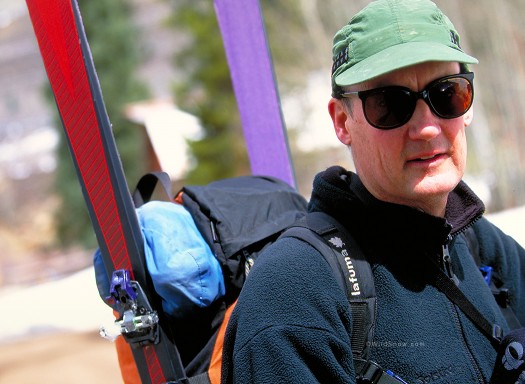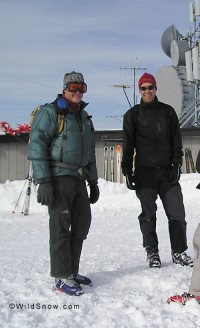(Condensed version of this is published in English version of the book “30 Years Dynafit Tech Bindings.” This is part two of yesterday’s book review.)
The first Dynafit bindings we saw here in cowboy country Colorado had the pink and purple little heel units that inspired as much confidence as using women’s underwear as a horse bridle. And I’m not talking about full coverage panties — but rather the most minimal string you can imagine.
In 1993 the first few pairs of bindings for possible retail sales were imported to the U.S. by California shop owner Lock Miller. No surprise I ended up with a set.
In those early days telemark skiing was the rage for ski touring in North America. Among the “televangelists” I was known as the bad boy who preached the apostate gospel of “AT,” (Alpine Touring bindings that latched down at the heel for downhill skiing). So Lock sent some of his first Dynafit bindings out to Colorado for myself and fellow AT skier, Michael Kennedy, to test and perhaps do some writing about.
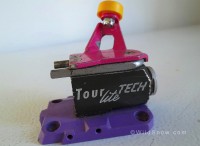
Our first tester, this is the same binding we received in 1993 for evaluation. The 'Purple' Dynafit began sales during winter of 1992-1993. It was one of the first of the Barthel tech bindings made and retailed under the Dynafit brand. Note the swappable spring marked with release value 7.
Having grown up messing around with mechanical things, I was immediately in love. The “Tour Lite Tech” reminded me of a finely made Swiss timepiece for the skier’s feet, tick-tocking as you walked, behaving like so many perfectly fitted tiny cogs and wheels.
On the uphill ski tour, we were stunned at how much energy the tech system saved over anything else we’d tried beyond lightweight Nordic race gear. Not only was the actual physical binding much lighter weight than others of the era, but “frame” type bindings required you to raise most of their weight twice: once when lifting your heel and binding frame during the stride, and again as you moved your ski uphill. This extra lifting of the frame used a lot of energy, and saving this “hidden” weight was an unexpected trick — along with obvious static weight savings — that the frameless Dynafits provided to those of us who adopted the binding.
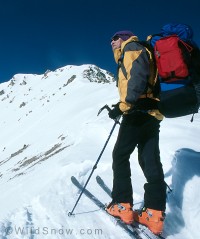
Me at Darling Pass, Trooper Traverse historical re-creation, Colorado 2001. This was the first time I'd used the bindings for a multi-day trip with a heavy pack. I was confident they'd pull through, and they did.
But it wasn’t all roses. The early bindings did not have readily adjustable upwards (vertical at heel) safety release. To tune release value, you had to take the binding apart and swap in a different U-shaped spring. This was not a user friendly process. In fact, if the binding was like a Swiss watch, you had to be like a Swiss watch maker to work on it. Moreover, the upward release springs were only available in release values of 6,7,8,9 with the hardest spring still being inadequate for strong skiing in situations such as moguls.
Acquiring these different binding parts in North America was not easy. In fact, it was nearly impossible, so we made do. With a number 6 spring your heel would come up and out occasionally, but the result was only a pretty telemark, which since it was stylish at the time was a benefit — that is until the subsequent face plant when your toe came out as well. All worth it, as saving weight was everything. Looking back from what I know now, I’m surprised we didn’t start learning Italian and wearing tight Lycra skin pants. Those things would come later to various degrees (yes, I did wear some tights), but I adopted the binding immediately and enjoyed the unfair advantage it gave me over friends who were lugging around gigantic frame bindings such as the Petzl.
Fast forward to 2007. I’m 55 years old, have spent my life as an alpinist, and I’ve never been to Europe. No Chamonix, no Alps, nothing. Why? So much to do in North America, budgets, and yes we love our wild west Colorado with vast terrain that’s virtually untouched. (Not to mention such proletarian pursuits as shooting guns and driving large automobiles, along with Alaska and South America for travel destinations.)
At any rate, Salewa decided around 2005 to ramp up their Dynafit branding and make a go of operating a “ski touring” company with their flagship product being the Dynafit binding. Public relations man Tim Kelley knew of me and my long time love affair with the binding. I’d been writing about it for years, beginning in (now gone) Couloir Magazine, and publishing on the internet with WildSnow.com starting 13 years ago.
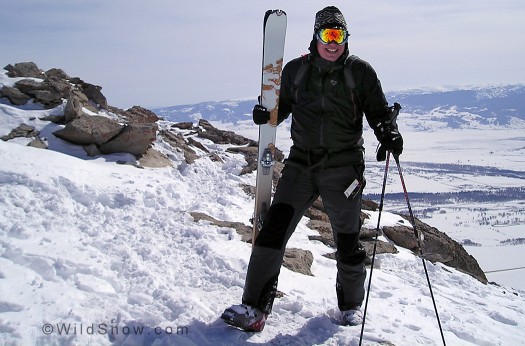
Reiner Gerstner during his visit to Jackson Hole in March of 2006, when we first met and he proposed that I ramp up my blog coverage of Dynafit by beginning a regular series of visits to Europe to experience the ski touring culture.
So Tim wrangled me an invite up to Jackson hole to meet Reiner Gerstner, who was working for Salewa & Dynafit to build the new Dynafit brand practically from scratch. Reiner knew of me from all my writings about tech bindings on WildSnow. He like to joke that I was the only guy on the planet who “knew more about Dynafit bindings than Fritz Barthel.” Reiner is an excellent networker, and “promised” that he’d have me over to Europe for the second annual “Dynafit Press Event.” With more than 30 years around publishing and outdoor industry glad handers I didn’t put much stock in what Reiner said that winter, but lo and behold, in January of 2007 I got a call from Tim Kelley, “pack for Europe.” The second press event was held in January of 2007 at the pink refugio accessed by the Solden (Soelden) ski resort cables in Austria.
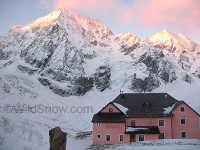
Dynafit Press Event 2007 was held at this old hut in the midst of what's now the Solden ski pistes, but plenty of ski touring nearby.
Tim and Dynafit went big with my trip, and let me attend their sales meeting as well as the press event. At the sales meet I got an insider view that few journalists are privileged to, seeing the business both from the employees’ point of view, capped with three days of journalist hype. For me, a high point of the event was the debut of the Zzero Green Machine — still one of the cleanest, most honestly engineered ski touring boots ever made.
But really, the highlight of that first trip to Europe was the human side. A few memories:
Reiner Gerstner, working hard on branding at the time. His amusingly exaggerated story about Dynafit’s Paulownia wood cores involved a Himalayan wedding and the “heart” of the ski. To make his point, Reiner would stand the ski up next to his red glowing face as if he was getting ready to kiss it. Staring out at the audience with eyes beaming out of his head like two Mercedes headlamps, he’d enunciate “bum-bump bu-bump ba-bump” with his hand patting the ski like a lover. “The hearbeat of the ski,” he’d say, “You can hear it if you… listen!” Despite the hyperbole what he said actually made sense — as Dynafit has continued to this day to make some pretty fine skis.
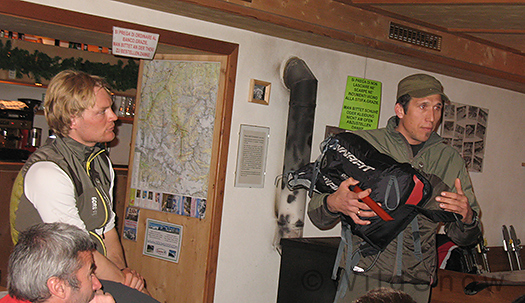
Benni looks on as Schorsch explains their new packs introduced during 2007 Press Event.
Schorsch Nickaes. He would work all day presenting product. Come dark, on went the aircraft bright headlamp. I’d never seen anything like these guys’ devotion to cardio skiing. I’d watch the headlamp beam sweeping the glacier above the hut. Later, it would flash in the window of the hut with the rhythm of the turns Schorsch made as he skied down after his workout.
Benedikt Boehm. He was at that 2007 press event. I’d brought over a few copies of my North American ski history book, “Wild Snow,” and gave Benni a copy after I discovered how much he enjoyed talking about future ski mountaineering goals. This was before Benni would become Dyanfit CEO as well as skiing several 8,000 meter peaks.
And then, Fritz Barthel. Dynafit would not exist as we know it without Fritz. He invented the binding.
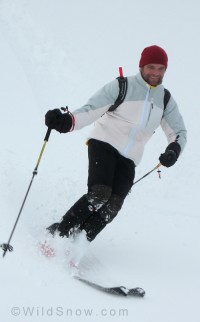
Fritz in 2007. We still laugh about his white outfits and how careful he had to be to prevent blueberry stains from the prevalent vegetation. The main thing is he skis so well and so smoothly he never needed a big binding with high release values. That fact was an important driver to the elegant result demonstrated in his invention.
Fritz is a tall man with a muscular build. In the U.S., it has been made abundantly clear to any skier that most Austrians skied out of the womb. This has to be true of Fritz, who skis in a playful style, blending techniques and vintages. Glue the feet together here. Wide stance there. Wriggle a few turns and bounce over a bump. Lay those boards over and make a squiggly carve down the piste. He is one of the best skiers I’ve ever skied with.
Mainly, when you see Fritz and his family ski, you know why those original bindings did not require “World Cup” racing strength or anything beyond release value 9. Smooth and fluid gliding over the snow asks little of a binding. (That said, it is amazing how strong nearly all tech binding models have proved to be over the years.)
Not only can Fritz go downhill, but he’s strong on the up as well. Mountain DNA was inherited from his father Manfred, who ski toured from youth into his 80s, and was doing 100+ days a season until just a few years ago.
Fritz and his family embody the spirit of ski touring in ways that prior to meeting them I’d imagined, but never experienced.
Along with the Press Event 2007, it was arranged for me to meet Fritz Barthel. I’d been tearing apart Dynafit bindings and publishing all sorts of details. The joke was that Fritz was wondering if perhaps over in the United States we had somehow created a surveillance system to acquire details from his Bad Haering workshop.
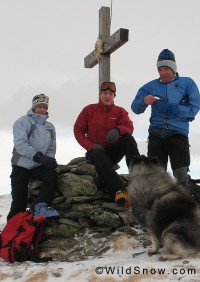
My first Austrian summit. Fritz is taking the photo, that's Manfred Barthel to the right, family friend Riki Leitner to the left.
So on a fine (actually cloudy, cold and quite disconcertingly dark) day in January I landed in Munich to be greeted by none other than the man himself. We immediately got along fabulously. Love of the mountains and all that, and love of small complex mechanical parts helped as well. We also shared a sense of humor that allowed constant riffing on everything from religion, to the differences between Germans and Austrians — and Americans of course!
I’d not had much experience with jet lag, and mentioned to Fritz that I wasn’t feeling up to par. He suggested a ski tour the next day as “the cure.” Wanting to hold my own with the legendary Tyroleans, I figured I’d just suffer through it, even though lying around the Barthel house drinking espresso seemed much more attractive.
The tour wasn’t long. Perhaps 900 meters of climbing. But we were “in the egg” the whole time — with as much visibility as if we were wearing stylish St. Anton headbands pulled over our eyes. My fitness was good so I was able to hold my place on the climb despite being wasted from traveling.
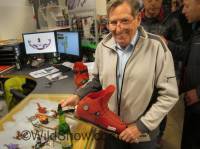
Fritz Barthel’s father Manfred, at Sol Austria in 2015 looking at historical Dynafit tech bindings on display.
After the traditional sitting, chilling our bones and sipping schnapps around the summit cross (I was waiting for the Barthels to change to lederhosen for the descent, but apparently that’s reserved for later in the bar), down we dropped. This is it, I thought. If I can’t ski they’ll send me back to the United States wrapped in an Austrian flag with a sign hanging from my neck that said “Tried to hang with Tyroleans — could not do it.”
Naturally, three turns off the summit my jet lagged brain checked out due to goggle failure and I did a full face body slam into a vertical cornice face. I must have looked like a wienerschnitzel hitting the deep fat fryer kettle. The Tyroleans were not impressed. Yes, the bindings worked. I also still have the Austrian flag hanging on my wall at home, as a memory of that fine day.
I’ve since redeemed myself with the Tyroleans (in my own mind, at least), and hung with a few of them on fairly big days. But when I need a little humble pie, all I have to do is think of my first day in the Alps.
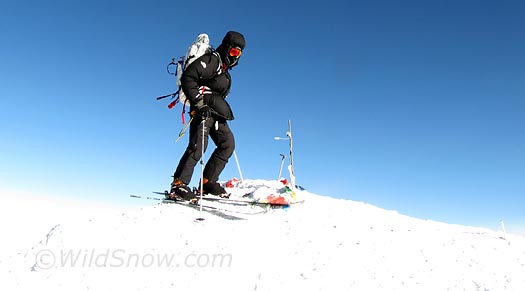
Me skiing off the Denali summit with my Dynafits, 2010. Snow off the summit and down to 17,000 feet was incredibly variable, everything from powder to super hard white-ice.
My only regret with my history with Dynafit bindings is that I never used them during the initial success of my “Ski the Fourteeners” project. I skied the last peak of the 54 Colorado 14ers in spring of 1991 on Silvetta 404s. Those were actually pretty good ski mountaineering bindings if you knew their limitations and work-arounds. The Dynafit tech binding was available in Europe at that time, but not yet proven for extreme skiing. Just a few years later I’d become a convert to Dynafit, drop literally pounds from my ski setup, and enjoy many more “bonus” fourteener descents on the “gear of the future” — as well as what might be my personal culmination of the tech binding, a Denali ski descent in Alaska with my son and his friends in 2010.
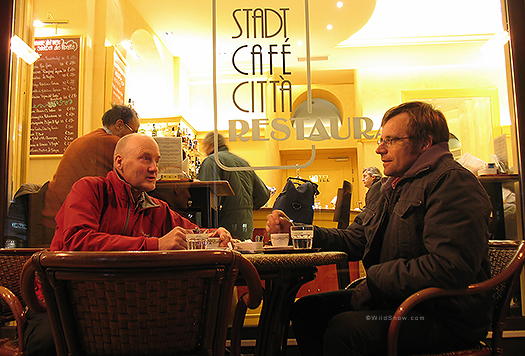
Fritz Barthel and I having an espresso in Bolzano, Italy, 2007. Fritz took me under his wing and showed me how to be a European, or at least tried. I failed by wearing a red jacket in an Italian city, but I tried to blend in with the hair style.
WildSnow.com publisher emeritus and founder Lou (Louis Dawson) has a 50+ years career in climbing, backcountry skiing and ski mountaineering. He was the first person in history to ski down all 54 Colorado 14,000-foot peaks, has authored numerous books about about backcountry skiing, and has skied from the summit of Denali in Alaska, North America’s highest mountain.

